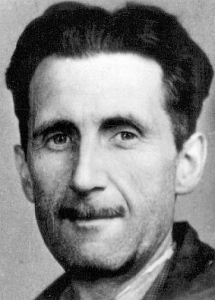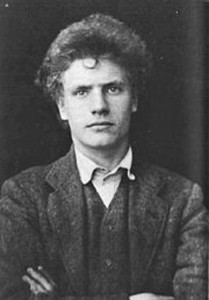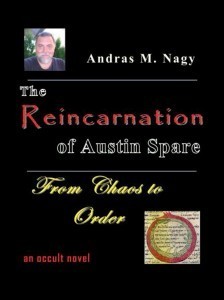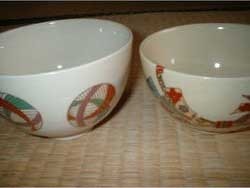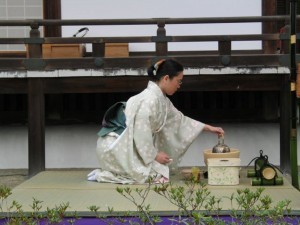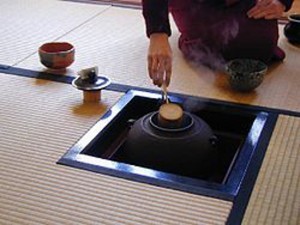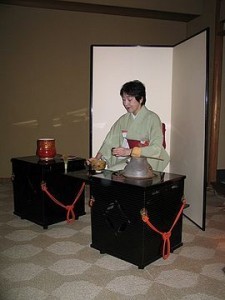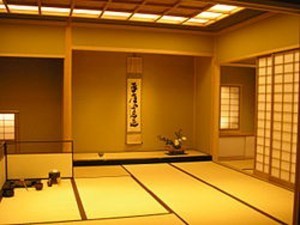Andras M. Nagy's Blog
May 2, 2016
Ramana Maharshi

Ramana Maharshi with the famous Cow
“One of the greatest enlightened men was Raman Maharshi, in South India, on the mountain of Arunachal. He was not a man of many words; he was not very educated either. He was only seventeen when he escaped into the mountains in search of himself. He was a very silent man, and people used to go particularly to have a taste of his silence.
One thing very miraculous was watched by every comer: whenever he sat in the veranda of the temple, waiting for people who wanted to sit with him in silence, a cow used to come without fail, exactly at the right time. She would sit there, and people could not believe it: “What kind of cow is that?” And when Raman Maharshi moved inside his room, and everybody dispersed, the cow would come close to the window and put her head inside — just to say goodbye, every day. And then she would go back. Then tomorrow she would come again.
It went on continually for years. But one day she did not turn up, and Raman Maharshi said, “She must be either very ill or she must be dead. I must go in search of her.”
The people said, “It doesn’t look right for a man of your heights to go in search of a cow.” But Raman Maharshi did not listen to the people, he went. People followed, and the cow was found. She had fallen in a ditch.
She had become old. She was coming, she was on the way, but she had slipped and had fallen into the ditch.
But she was still alive, and as Raman Maharshi reached her, sat by her side, the cow had tears in her eyes. And she put her head into Raman Maharshi’s lap and died.
Raman Maharshi told his people,”A great temple should be made in her memory here, because she has died enlightened — she will not be born even as a human being.” And even today the temple stands there, with a statue of the cow inside.
Perhaps we have not made much effort to communicate with animals, with trees, with mountains, with rivers. Certainly their language cannot be our language; some other ways have to be found. But in silence many people have experienced a harmony with the trees, with the animals, with the birds.
So it is not only a parable, it is also an indication of a possibility for the future. Man just has to explore… there is so much to explore! But we are engaged in trivia. We are not concerned with the real and great values of life. We are not concerned even with life itself and its different forms. All these are different forms of the same life which we are made of — the same stuff. There must be some way of communion.” from OSHO – Zarathustra: The Laughing prophet, Chapter-20
Share on Facebook
The Eighth Technique
December 7, 2015
Non-dualism
Q. What is the difference between relative and absolute reality?
This has puzzled me ever since I embarked on my journey of self-exploration and metaphysics. Denying duality; the existence of good and evil, light and darkness is going against the self-evident. Our earthy existence is noting but polarity. But how real is this? Your question is pertaining to the age old dilemma;
Are the demons and gods REAL or perhaps they are our mental projections in this fragmented “reality” where our mind is in the driver seat. Religion teaches us to deny the body. Ascetics are silly. It is not the body you must deny but your mind. The mind is the self. The ego. It is always looking outward and in need of something. Searching for the TRUTH! In this framework Karma and Reincarnation are also driven by our mind. All the teachings of religious doctrines are nothing but the projection of our mind. When I say “our”, I naturally refer to the collective sentient beings in this Universe and beyond. Duality is as “real” as Karma or Reincarnation. It is a projection of our consciousness. We cannot fathom non-duality as we cannot fathom infinity. Our mind is just not set up to deal with this. Thus we invent all this other stuff. Negative and Positive energies are like vortices – like attracts like.
The answer is within you. All you need is to unlock the door. You do not need to be in any religious doctrine or faith.
Does this mean you can do anything and get away with it? The answer is NO. All sentient beings are inherently divine and the collective hive of the higher selves of sentient beings makes sure that Cosmic “laws” would work forever.
Q. Does this mean there is no god?
God (the god particle) is within us and everything else. Collectively there is a god, the Oneness (Infinity).
Namaste
Share on Facebook
July 24, 2015
a little taste of Tantric Enlightenment
Many people associate tantric practice with casual sex but that is not what Tantra is all about. Contrary to the ascetic philosophies, the tantric way embraces our feminine and masculine inner qualities, the sounds of mantras, external beauty and joy as a venue to enlightenment. Since Tantra is a more expedient way to enlightenment, naturally it should be closer to our instant gratification seeking Western culture. However, as with most things Eastern we tend to misinterpret many of the Tantric venues, if the books are any indication to our current understanding.
Tantric practice transmutes the energy of desire, realizing that the Universal and primordial divine energy is already within us. We just have to allow it to surface. That is not accomplished by thinking or learning but by letting go, allowing the sounds of mantra to liberate us from our physical imperfection and prison.
All religion uses some forms of music or chanting to accomplish something similar to tantric chanting. We have the hymns in Christianity, canticles in the Kabala, dancing and music in the Sufi tradition, similarly the Buddhist and Hindu tantric practice uses mantras as the vehicle to liberation.
I will not write a comprehensive essay on Tantric chants but point the reader to certain, functional websites to further study. I disagree with the traditional Buddhist way of finding a right Lama to finally accomplish this enlightenment. It is, in my opinion not practical nor very easy. I believe you can practice on your own with the purpose of making this planet a better place for all its inhabitants and not only for your selfish needs, then you will somehow find the way to accomplish this. However, if you are fortunate to have found the right Tantric teacher then by all means do what is natural and learn with his/her guidance.
The Magic of IHVH-ADNI is focused around a Hebrew kabalistic phrase which is spoken musically, almost in the manner of singing.
ANI – IHVH ADNI – RBVNV ShL OVLM – AMN
(Ani – Yod Heh Vav Heh Adonai – Ribbono Shel Olam – Amen)It is “canted”, so to speak, but in a magical way involving mental, astral and physical utterance. To this three-body speech is added the visualization of specific energy movements which occur in sync with the canticle. Rawn Clark is the person who first introduced this old kabalistic magical canticle online, and he graciously developed a course to properly learn to pronounce and sing it. His course can be found http://www.abardoncompanion.com/TMO-Links.html
The Medicine Buddha Mantra
Tayata
Om Bekandze Bekandze
Maha Bekandze
Radza Samudgate Soha
The mantra means:
May the many sentient beings
who are sick,
quickly be freed from sickness.
And may all the sicknesses of beings
Never arise again.
A good source of Buddhist mantras is the http://www.worldwidehealingcircle.net/index.html
And finally the Manjushri Mantra; ”
Om Ah Ra Pa Ca Na Dhih
Share on Facebook
July 9, 2015
Karmic Husk
We are constantly involved with people from our past life. But how that complicated entanglement manifests itself and how to resolve it is a question very few books will tell you. Let me, for illustration purposes, quote a story from my teacher’s Guru, RHH’s book; “Talk Does not Cook the Rice”. The word “Husk” implies that when realizing what is going on (always the first step) and properly acting will dissolve the Husk and allow us to move forward in our spiritual progress.
“A young lady had been engaged to a man for 18-years, and their purported marriage was a constant source of arguments, a battle back and forth..She came to me for advice one day, why they could not be married? I said, “I rather you ask yourself this question and when and if you have the answer, you come back to me and I verify that, If I tell you now, you will accept it on an intellectual grounds and you would feel it was right or perhaps not, but like with deep esoteric matters, if you put it to the test, then it would come from within and then it is an experience and you’d KNOW first hand, not secondhand…
A few months later she was back and told me; “I know the reason…In a former life in Italy, I was Jewish and I was involved with a Roman. Now(in this life) he is Jewish and I am Catholic, and he has a complex of being Jewish and the whole idea of intermarriage just makes him worry.
In our former life I as a Jew lived in a Ghetto and there were strict laws against intermarriage (as a Roman your wealth was to taken away if they suspected any involvement) . But we secretly and in a hidden way managed and we even had a son together. Our mother wisely suggested we give our child to a relative to raise and the boy grew up with I pretending to be a nanny to be with him. The boys father died in a chariot race, and when he was sixteen, I revealed to him who I was (his birth-mother) and how he was a half Jew. But he got upset and threw me out and sent me back to the Ghetto. One day, I was knocked down on the town square by a horse and I broke my back. As I looked up, dying, in a flashback I saw the face of the man, my son, and he was the same man I am involved in this lifetime!
Then, I have realized that we cannot marry until we resolve this karmic entanglement somehow and release it. Marriage would not suffice. This is what the ancient wisdom call Karmic Husk and it is more common than many realize.”
Marriage in this case would have been foolish, but realizing what had happened and discussing and releasing thee karmic husk via forgiveness would have been the proper solution.
Share on Facebook
July 2, 2015
Hermetic Coaching
I am opening an informal school for Hermetic philosophy, in the form of mentoring. The dissemination of information will be individually handled, ideally, face-to-face or by Skype. I am not interested in making money but I am keen on finding minds that are ready in terms of spiritual age and maturity. I will not accept everybody and there will be an informal discussion before we proceed with the mentoring.
If you are interested or have some questions please respond to this post or my contact form.
Share on Facebook
February 26, 2015
We Have Lost our Soul
What George Orwell had so acutely observed seventy years ago, escapes this current administration and for the most part the European community. Young people want adventure and a cause. Here in the US we are complacent and we have lack of spirituality and grit. Of course you will argue with me that, “oh, but we are spiritual, we meditate, we pray”, after all there are so many venues, churches, meditation groups etc to confuse the youth who has some “itch to be scratched” . So why is that we have our youth joining a death cult, based on erroneous and evil interpretation of Islam? Why the youth wants socialism in America, akin to EU style welfare state, in their acts they yearn the opposite. Basic human nature is to get involved with something bigger than ourselves, something spiritual and Historic, impacting our social and spiritual maladies as society. The EU is just as rotten than beltway of Washington, DC.
There is no easy answer but this should be a warning to the establishment, things are brewing in the air and sooner or later change is coming! Times are no different today that they were before 1848 Imperial Europe where the French revolution triggered fear and apprehension all across the continent of Europe. Here is what Orwell wrote about Hitler;
“Hitler has grasped the falsity of the hedonistic attitude to life. Nearly all western thought since the last war, certainly all “progressive” thought, has assumed tacitly that human beings desire nothing beyond ease, security, and avoidance of pain. In such a view of life there is no room, for instance, for patriotism and the military virtues. The Socialist who finds his children playing with soldiers is usually upset, but he is never able to think of a substitute for the tin soldiers; tin pacifists somehow won’t do. Hitler, because in his own joyless mind he feels it with exceptional strength, knows that human beings don’t only want comfort, safety, short working-hours, hygiene, birth-control and, in general, common sense; they also, at least intermittently, want struggle and self-sacrifice, not to mention drums, flag and loyalty-parades…. Whereas Socialism, and even capitalism in a grudging way, have said to people “I offer you a good time,” Hitler has said to them “I offer you struggle, danger and death,” and as a result a whole nation flings itself at his feet.
My fear (and sadly prediction) is that ISIL came and it will be gone, but as ISIL took the baton from Al Qaeda, there is something will replace ISIL as ideology. Less murderous perhaps, less dogmatic of Sharia. Our ways are of the dinosaurs, we do not have capitalism anymore nor democracy. Furthermore, we also have lost our soul.
Share on Facebook
October 30, 2014
Bipolar and Spirituality
There is a link between super sensitivity/spirituality and bipolar and /schizophrenia in the context of hearing voices/seeing things and elevated importance(delusional thinking) or being persecuted. Past life memories or acknowledgment is not specifically mental illness clue unless it accompanies much of the above (feeling persecuted, elevated importance, hearing voices and seeing things such as aura etc).
Two years ago I was told I was bipolar II (or Cyclothymia) and I indeed had some delusional experiences when I “found out” about my possible past life as Austin Spare. I will not specifically get into details but I will say my delusional thinking was rather oblique and mild compared to some. This however does not invalidate the realness and factual nature of reincarnation and the existence of some mental illness among its midst.
I think what is considered to be “real” and not is often determined by idiots and charlatans. I dislike the word mental illness even as I have to accept that is unfortunately all too real. I am not taking any medication. now (only occasional sleeping pills) and I am often ostracized and criticized for this by my peers who are brainwashed by the medical establishment doing the bidding of big pharma. Having said this, I know from going to a support group that some of us need the medication just to survive and function daily.
After, my spiritual teacher and I have parted ways I have decided to study Hermetic philosophy and naturally what followed was hermetic magic. It was a great eye opener to me but it lead me to assume some false assumptions.
After being diagnosed I have stopped writing here and I was now afraid of my spiritual side because, now it equated to me delusional thinking and inflated ego, both tell-tales of bipolar mania.
Share on Facebook
December 4, 2012
My Reincarnation Story or writing about Austin Spare
Finding out about my past life was both exhilarating and disturbing experience. I was never intended of seeking to find out about my past life, thinking that I most likely was a person like million other cases, an unknown, undocumented personality, whose life is hidden behind the veils of history.
I was drawn to mysticism and magic since my late education and initiation into an obscure type of Yoga, called Agni Yoga. After my fall-out with my teacher I begun my solitary journey that eventually had lead me to Hermetic philosophy and later Chaos magic. This is when, purely as a coincidence, I have discovered Austin Osmond Spare, the Edwardian, mystic and artist.
It must also be told that while I was born and raised in Budapest,Hungary, I was an anglophile as early as I remember. My reading and education both lead me to the English culture and literature. I have attempted to immigrate to England first and only after I was refused, I looked into emigrating to Canada or the United States.
Austin Spare died in the Spring of 1956 and I was born in December 1956.
Spare died of a burst appendix and while I’ve never overly concerned myself with my health, the concept of appendicitis, inexplicably has always gave me alarms. I would guess our dying leaves an imprint, a memory that sometimes stays around and can get carried over into the next incarnation.
My life and childhood was non-typical for a Hungarian youth. I was very self-conscious and inhibited with women but I was drawn to older women for comfort and sex. This pattern is a repetition of Spare’s sex life. I never had any homosexual experience nor the inclination or curiosity but I had certain effeminate characteristics that gave out false signals and I was approached by gay men throughout my life. This is also a very Spare-like attribute.
I loved doodling and drawing of pictures of animals and persons. My mother encouraged my artistic persuasion while my father told me that I needed to learn something I could support myself with. In addition to drawing and painting I loved cats and other animals as well. I was frequent visitor in the Zoo. To this day I am obsessed with cats.
After discovering my past life I begun reading and studying the life and works of Austin Spare and wanted to go deeper. I wanted to know what was before Austin Spare. Who was he/us, before that time? This overactive curiosity eventually got the better of me. I stated imagining things and started actually believing them. Of course there is no proof or definitive verdict that I was Austin Spare. I believe in my own instincts and inner guides, coupled with certain facts about me that I know, that others might consider lesser importance, would not believe the same way as I. This paper or my book is not about convincing anybody. Certain people who are predisposed against the idea of reincarnation and karma would never believe my story, no matter how much convincing I could muster. Similarly, those who are friendly towards the idea of reincarnation would find my story completely plausible and believable.
The idea of writing a fictional story – partially based on biographical facts, largely based on imagination and the freedom of the novelist. Ideas expressed via a novel do not need to be explained, rationalized or proved. They have to be told, interestingly and with believable and well developed characters.
Figure 1 Austin Spare as a young man.
The Synopsis of the Novel
“During the cold war, Mihai finds himself an orphan and a new immigrant in America. When there is a shooting during their daring escape attempt on the border of Yugoslavia and Italy only Mihai manages to escape He finds himself in America alone and without a clear purpose, playing poker and using his magic to get buy. Mihai is discovering that he is also a natural magician. Through the power of his will and imagination he can conjure up cards. After a while Mihai’s skill to do magic is gradually fading and he must find work. After a series of attempts to find happiness in self-indulgence and gaining material wealth, he finally finds his purpose and solace after a chance encounter with Raphael, an old and mysterious man in Ashland,Oregon. When Raphael, who is also a spiritual teacher, reveals to Mihai that he is the reincarnated Austin Osmond Spare(AOS), the Edwardian painter and occultist. This revelation changes our protagonist forever. Researching the life and deeds of AOS leads him further into the occult. When Raphael dies, before he has a chance to Initiate him, Mihai’s life again becomes disoriented. Gradually he starts making contacts with the subtle world, where he receives guidance and instructions. Is he in contact with his Guru or something more sinister? Is he losing his mind or his visions are real? Will he find out his life’s karmic lesson that his past self has now to learn in order to move up on the “spiritual ladder” and find peace and joy, or will he repeat the “class” again? …
This serial book will be re-titled and republished as Reincarnation of Austin Spare: from Chaos to Order
Now this book is being published as a serial novel – by chapters on Amazon, KDP Select (free for 5-days).
http://www.andras-nagy.com/MagicalLife.html
Visit our Face book Page
http://www.facebook.com/pages/The-Circle-of-Life/123175034487363
This book is about Magic, Reincarnation and Karma while coming of age.
Share on Facebook
March 13, 2012
The Zen of Tea
Tea began as a medicine and grew into a beverage. In China, in the eighth century, it entered the realm of poetry as one of the polite amusements. The fifteenth century saw Japan ennoble it into a religion of aestheticism–Teaism. Teaism is a cult founded on the adoration of the beautiful among the sordid facts of everyday existence. It inculcates purity and harmony, the mystery of mutual charity, the romanticism of the social order. It is essentially a worship of the Imperfect, as it is a tender attempt to accomplish something possible in this impossible thing we know as life.
Tea may, of course, be served without any formality. Hot water may be poured over ordinary tea without thought as to the manner in which it is done. But those who practise the art of Cha-no-yu follow a regulated mode of serving with utensils carefully selected and correctly arranged. It is the elaboration of details which gives additional pleasure to the tea-drinker.
Training in the serving and drinking of powdered tea includes nearly all phases of etiquette observed in the Japanese mode of living. For this reason young ladies are encouraged to take lessons in the tea ceremony before marriage. Through this medium they learn correct manners and deportment. Nor is this training useless for older people.
Opening the sliding-door of the service room, the hostess makes a bow before entering the tea-room. It is interesting to observe the elementary lesson of how to bring in the water-jar, which has to be placed in a prescribed position. She leaves the room to reappear immediately, holding the tea-caddy in the right hand and the bowl in the left. She then makes another trip before she sears herself in front of either the stationary hearth, or portable fire-brazier, as the case may be, according to the season.
It would, however, be extremely difficult, if not impossible, to appreciate the fundamental ideals and traditions of Cha-no-yu without knowing something of the philosophy of life and art according to Zen Buddhism.
Meditation and introspection are stressed in the Zen philosophy, and the habit of individual and independent thinking is cultivated. It is natural that the inadequacy of words as vehicles of expression should be recognized. In the mental discipline of Zen, concentration is considered more important than anything else, and devotees are taught to cultivate direct communion with the inner nature of things in order to arrive at truth. The value of suggestion and intuition are therefore emphasized by those who follow Zen traditions.
Cha-no-yu is now a secular pastime, as we have seen. Neither religion nor philosophy has much to do with the cult as it is today. However, the canon of preferring plainness and austere simplicity to elaborate decoration cannot be accounted for except as being of Zen origin.
Paintings in black and white by Zen monks and artists, creating an atmosphere of transcendental calm, are highly prized for their simple, but subtle and suggestive beauty. For the same reason, hanging scrolls bearing inscriptions by the ancient Zen monks are still used for Cha-no-yu parties. The sentiments expressed may be moral or religious, but they are characterized by untrammelled aloofness from dogmas and creeds, and exercise a liberating influence upon the mind. The free and natural strokes of the ideographs, which are different from the more regular styles of the ordinary calligraphers, suggest the writer’s freedom from worldly emotion and passion.
Only a small section of the Japanese people understand the institution of Cha-no-yu, but the common intuition of seeing true beauty in severe simplicity and refined poverty may be considered a racial trait. This characteristic phase of Japanese life may also be traced to the ideals inculcated by the early masters through the medium of the tea ceremony.
With the introduction of Western modes of civilizationJapanhas undergone changes in many directions; the beauty of chaste simplicity is often sacrificed to ugly vulgarism, which characterizes all cheap copies and imperfect adaptations. Nevertheless, the inborn love of simplicity is so deep-rooted that it is discernible, not only in the art and architecture ofJapan, but also in the daily life of the Japanese people. The influence of the tea cult is to be seen in the Japanese home even though nothing be known of ceremonial tea.
Having observed the tea-master’s way of training his pupils, and having taken part in more than one entertainment, the readers will have noted that Cha-no-yu is related to nearly all branches of arts and crafts, as well as to various phases of Japanese home life. It is its many-sidedness that makes Cha-no-yu one of the most interesting aesthetic pursuits.
The love of chaste and refined simplicity, which is the key-note of the Japanese cult of ceremonial tea, has exercised a wholesome influence upon architecture, pottery, landscape gardening etc. For those who are satiated with looking at elaborate, tawdry and pretentious works of art, it is a relief to discover subtle beauty and refinement under an inornate and almost barren aspect. When accomplished tea-masters and devotees give entertainments, they know how to attain artistic effect without depending upon what is colourful and gaudy.
Pottery is perhaps the most important of the industrial arts allied with Cha-no-yu. The ceramic art ofJapanis greatly indebted to tea-masters and devotees for its refined taste, which has inspired artisans. Some knowledge of ceramics is therefore essential for the full enjoyment of a Cha-no-yu entertainment, at which by far the larger part of the utensils are of pottery. Any guest not interested in pottery will disappoint his host. Such a guest invariably fails to appreciate the tea-bowl, caddy, receptacle for fresh water, etc., of which the host is highly and justly proud.
There are builders and carpenters specially trained to build houses for ceremonial tea. In order to appreciate that artistic value of the work of these specialists, one has to acquire the taste for a plain style of architecture. It is natural that a devotee who is about to have his own Cha-no-yu house should make an intensive study by paying careful attention to the minutest details of the building plan.
Nor is the art of landscape gardening less important. The fundamental principles as evolved by ancient masters like Rikyu and Enshu are observed today in laying out new gardens. The deeper our knowledge of the Japanese art of landscape gardening, the greater will be our enjoyment when invited to inspect any garden, even though not connected with Cha-no-yu.
None but a person with an artistic sense strongly developed is capable of arranging flowers in a simple but highly effective way, which is so characteristic of the alcove decoration at a Cha-no-yu party. Should a guest fail to appreciate the vase and flowers arranged in them, his host might never invite him again.
No host would blame those unfamiliar with the Japanese language and literature for their indifference to hanging scrolls bearing inscriptions. A knowledge of textiles will, however, be helpful in appreciating the quality of the ancient brocade used in mounting them.
Devotees of the tea cult are also expected to be connoisseurs of lacquer ware, and those with scanty knowledge of iron and bronze will be incapable of admiring the antique kettles and vases of rare value.
The art of cookery is one of the most important subjects, because the kaisekimeal is served at a regular Cha-no-yu party. Those but slightly interested in the culinary art will make unsuccessful hosts, no matter how superior they may be in their possession of rare works of art. Fastidious epicures who praise an excellent menu might disappoint their host, should they remain insusceptible to the artistic superiority of the china dishes and lacquer bowls selected for the meal.
It will therefore be realized how profound a devotee’s aesthetic pleasure may be, if he makes a study of one subject after another allied with the tea cult, which has exercised a deep refining influence upon the arts and crafts of Japan for hundred of years. It is sincerely hoped therefore that facilities to become more familiar with Cha-no-yu may be extended to those who desire to penetrate more deeply into the cultural life of the Japanese people.
Share on Facebook

